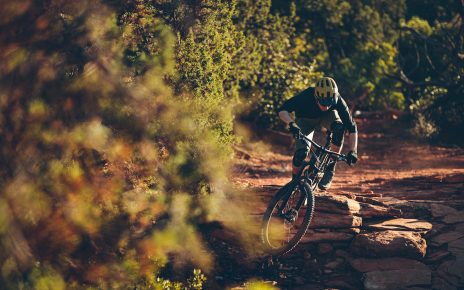Rocky Mountain Slayer Carbon 90
Words by Mike Kazimer, photography by Trevor Lyden
Along with the two different wheelsize options, the Slayer is available with either a carbon front triangle and an aluminum swingarm, or a full aluminum frame. All of the frames have Rocky’s Ride-4 adjustment system, a flip chip located at the rear shock mount that allows for, you guessed it, four different geometry settings. Most of the testing took place with our size large bike in position 2, which gives it a 64.1-degree head tube angle, 76.1-degree seat tube angle, and a 471mm reach.
• Travel: 170mm rear / 170mm fork
• Aluminum frame
• Wheel size: 29″
• Head Angle: 63.8° – 64.8° (geometry)
• Seat Tube Angle: 75.8° – 76.8°
• Chainstay Length: 442 / 440mm
• Sizes: M, L (test), XL
• Weight: 33.2 lbs (as tested)
• Price: $7,999 USD
• www.bikes.com
Our test bike was the 29”-wheeled Carbon 90, which is spec’d with a 170mm Fox 36 Factory fork, DHX2 coil shock, Shimano XTR drivetrain and brakes, and Race Face ARC 30 rims laced to DT Swiss 350 hubs. All that adds up to a retail price of $7,999 USD.
Yes, there’s an elephant in the room, but let’s take a moment to briefly go over how the Slayer performed before testing was abruptly cut short.
Climbing
The Slayer was designed with descending in mind, but the seated climbing position is comfortable enough that skipping the shuttle truck and pedaling back up to the top every so often is completely feasible.
It has a steep actual and effective seat tube angle, which means that even when the dropper post is fully extended the seat doesn’t end up too far behind the bottom bracket. That centered position, combined with chainstays that never felt too long or too short helps make the Slayer a competent climber, although it doesn’t feel as efficient as the Yeti SB165 or the Specialized Enduro. That’s where the climb switch on the DHX2 coil shock comes in handy – a turn of the blue lever is all it takes to calm the back end down for those longer logging road grinds.
Descending
For a bike with 170mm of travel and 29” wheels the Slayer was surprisingly nimble; there was an unexpected level of liveliness that allowed it to remain enjoyable on tighter, slower speed sections of trail. It did well on the higher speed straightaways, too, although it’s not quite stable and planted enough to earn it the mini-DH buzzword – it feels more like an enduro bike with a little extra travel.
There were a couple of instances on steeper section of trail where the front center felt a little short, despite the fact that the 470mm reach isn’t out of the ordinary for a bike like this. It’s possible that going with a slightly longer stem could have resolved this, but unfortunately we didn’t get the chance to experiment. Moderate hits were handled well (except for one…), with enough ramp up to prevent any harshness at the end of the stroke.
It Broke
The Pinkbike Field Test isn’t meant to be a test of long term durability; instead, the intention is to get a solid grasp on a bike’s handling and component performance over the course of a few weeks of riding. Unfortunately, we ended up finding the limit of the Slayer’s strength during a warm-up lap down Whistler’s famous A-Line trail.
Disaster struck on the third to last jump. Test rider Luca Cometti hit the jump the same way he had on multiple bikes before, landing a little deep but with plenty of transition left, only to have the back end of the bike break on impact and toss him to the ground on the side of the trail. A trip to the clinic was in order, and while he was lucky to escape more major injuries, he did break a couple of ribs and sustained enough bruising that his time at the Field Test was over. Not good.
What Exactly Happened?
We don’t know. Our current working theory is that upon landing, the Rocky-branded axle snapped at the driveside threads, causing the wheel to twist and tear the non-driveside chainstay apart. We wondered if maybe an early sample of the alloy rear triangle didn’t get a proper heat treatment, but testing it for hardness showed that it measured within Rocky Mountain’s parameters, so that wasn’t the problem. The axle itself was neither overtightened nor loose; we had a certified mechanic doing the tire swaps (for control tires) and re-installing the wheels on the bikes—so we know it wasn’t Levy’s huge guns that caused this.
To their credit, Rocky Mountain didn’t give us the ‘pre-production’ excuse – the bike we had was a full production model. The Slayer also far exceeded all of Rocky’s in-house and third-party testing before production, which made the failure we experienced even more surprising to them.
Rocky’s position is that despite this failure, the Slayer is safe to ride. They issued the following statement:
So is there simply not enough material around that cool looking blind pivot? Are other bikes from other brands out there time bombs just waiting for an axle failure that would cause them to tear apart like this? All the bike strength tests we know of assume the structural integrity of the axle, so that is certainly possible. We don’t have those answers today.
We had high hopes for the Slayer, but because it broke during riding conditions that should have been well within the realm of its capabilities, we can’t recommend it—for now. We hope the reasons for the failure become clearer, and Rocky Mountain can address any issues quickly. Once that happens, we’ll give the Slayer another try.












